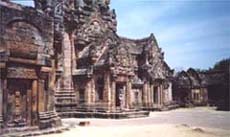
Prasat Muang Tam
It is just 8 km away from Prasat Phanom Rung, by a concrete road through paddy fields.
The temple is surrounded by a community called Ban Cho-ra-ke Mak. In front of the car park there is a small shop cum museum displaying books and photos of Khmer architecture. The entrance gate opposite the museum charges entrance fees (10 Baht for Thai and 30 Baht for a foreigner).
There are local houses, a Thai temple and a school nearby the Khmer sanctuary.
In the low tourist season the site looks solitary and magical. The complex is surrounded by two walls. The inner wall is made of sandstone while the outer one is made of laterite. Sandstone archways at opposite points perforate the perimeter on all four sides. The lintel, pediment, and side columns of each archway are carved into scenes from Hindu myth.
There are four L-shaped ponds located between the outer and inner walls. At the center of the compound there are 5 Chedis all made of brick and built on a single laterite foundation.
It is comprised of 13 main parts. Part one is the stairway starting near the car parking. From this point you could not see any buildings until you walk to the end of the stairway. Then there is a pavilion setting on the right side, at the end of the stairway.
The third section is the flat pathway with columns on both sides. It leads to "Naga bridge", the section four. Next, there are 52 steps leading to the top of the hill. This construction connects to part six, the bridge linking to principal tower.
 The second level Naga bridge, the boundary gallery, and the third level Naga bridge are located before the main building. The main square based tower is made of pink sandstone, which is 9.2 meters width and 23 meters tall.
The second level Naga bridge, the boundary gallery, and the third level Naga bridge are located before the main building. The main square based tower is made of pink sandstone, which is 9.2 meters width and 23 meters tall.At the center of the building there is the "Shiva Lingam ", the most sacred religious object. There are two stone building and one minor building to the northeast and the southwest of the main building. In front of the tower, to the northeast and the southeast, are two laterite buildings used as libraries.
Normally visitors would walk up the ladder from the bottom. However you can drive up to the summit and park just behind the compound for a fee of 50 Thai Baht for a van. Entrance fee for visitors is 40 Thai Baht each for foreigners, and 20 Thai Baht each for Thais.
Every year in April there is a cerebration. Many tourists come to celebrate and worship at this ruin. There are display of beautiful parades, north eastern style dinner, traditional shows, sound and light show. In 2003 the cerebration takes place on 5 and 6 April.

Plan view of Prasat Phnom Rung temple (Buri Ram)
 1 = Stairway
1 = Stairway2 = Pavilion
3 = Pathway (flat)
4 = Naga bridge
5 = Stairway leading to the main tower
6 = bridge to the main tower
7 = Second level Naga bridge
8 = Boundary gallery
9 = Third level Naga bridge
10 = Main tower
11 = Minor tower
12 = Brick tower
13 = Library
 Naga Issuing From Makara,
Naga Issuing From Makara,Unusually, this balustrade (in front of the mandapa) shows the naga issuing forth from the mouth of a makara. There is a modern example located near Kamphaeng Yai.
Makara,A chimera that is part water-snake and part crocodile or fish, usually with an elephant snout. It is a frequent decoration on balustrades, arches, waterspouts, and offering overflow spouts
Naga,The water-snake, whose cultural iconography and mythology was inherited from India via Southeast Asia. In temple decoration, both the balustrade and the framing arches of niches and doorways are often carved in the shape of nagas (usually, in those cases, a snake's body with a makara head.)








